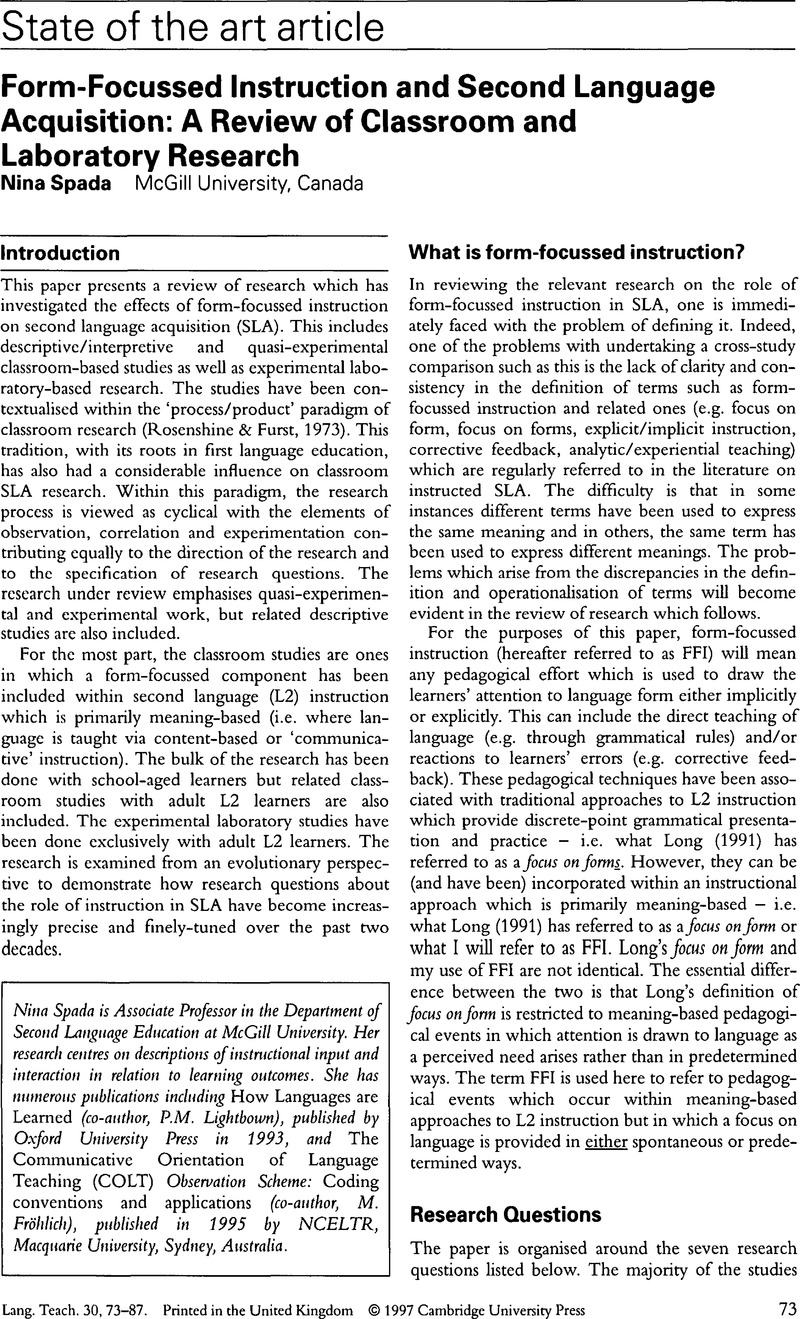Crossref Citations
This article has been cited by the following publications. This list is generated based on data provided by Crossref.
Neil, PS
Salters, J
and
McEwen, A
1999.
Teachers' use of target language in the German classroom.
The Language Learning Journal,
Vol. 19,
Issue. 1,
p.
12.
Lyster, Roy
1999.
La négociation de la forme: la suite … mais pas la fin.
The Canadian Modern Language Review,
Vol. 55,
Issue. 3,
p.
355.
Jean, Gladys
1999.
L'intégration de la grammaire dans une approche interactive/expérientielle en français de base.
The Canadian Modern Language Review,
Vol. 55,
Issue. 3,
p.
315.
Wright, Margaret
1999.
Grammar in the languages classroom: findings from research.
The Language Learning Journal,
Vol. 19,
Issue. 1,
p.
33.
Sheen, Ronald
2000.
A Response to Nassaji's ‘Towards Integrating Forum-focused Instruction and Communicative Interaction in the Second Language Classroom’ in Light of Issues Related to Focus on Form.
The Canadian Modern Language Review,
Vol. 56,
Issue. 3,
p.
496.
Macrory, Gee
2000.
Learning to Teach Grammar in the Modern Foreign Languages Classroom.
Research in Education,
Vol. 64,
Issue. 1,
p.
1.
Macrory, Gee
and
Stone, Valerie
2000.
Pupil progress in the acquisition of the perfect tense in French: the relationship between knowledge and use.
Language Teaching Research,
Vol. 4,
Issue. 1,
p.
55.
Lasagabaster, David
2000.
El papel de la literatura en la clase de lengua extranjera.
Cultura y Educación,
Vol. 12,
Issue. 3,
p.
67.
Allford, Douglas
2000.
Pictorial images, lexical phrases and culture.
The Language Learning Journal,
Vol. 22,
Issue. 1,
p.
45.
Williams, Jessica
2001.
Focus on forms research and its application.
Revista Brasileira de Linguística Aplicada,
Vol. 1,
Issue. 1,
p.
31.
Ellis, Rod
2001.
Introduction: Investigating Form‐Focused Instruction.
Language Learning,
Vol. 51,
Issue. s1,
p.
1.
Turner, Karen
2001.
The National Literacy Strategy — what's in it for modern language teachers?.
The Language Learning Journal,
Vol. 24,
Issue. 1,
p.
37.
Zahar, Rick
Cobb, Tom
and
Spada, Nina
2001.
Acquiring Vocabulary through Reading: Effects of Frequency and Contextual Richness.
The Canadian Modern Language Review,
Vol. 57,
Issue. 4,
p.
541.
Williams, Jessica
2001.
Learner‐Generated Attention to Form.
Language Learning,
Vol. 51,
Issue. s1,
p.
303.
Katz, Stacey L.
2001.
Videoconferencing with the French‐Speaking World: A User's Guide.
Foreign Language Annals,
Vol. 34,
Issue. 2,
p.
152.
Oukada, Larbi
2001.
Toward Responsive Beginning Language Curricula.
Foreign Language Annals,
Vol. 34,
Issue. 2,
p.
107.
Harrington, Michael
and
Levy, Mike
2001.
CALL begins with a “C”: interaction in computer-mediated language learning.
System,
Vol. 29,
Issue. 1,
p.
15.
Saliés, Tânia Gastão
2002.
Simulation/Gaming in the EAP Writing Class: Benefits and Drawbacks.
Simulation & Gaming,
Vol. 33,
Issue. 3,
p.
316.
del Pilar Garcı́a Mayo, Marı́a
2002.
Interaction in advanced EFL pedagogy: a comparison of form-focused activities.
International Journal of Educational Research,
Vol. 37,
Issue. 3-4,
p.
323.
Hendrix, Liesbeth
Housen, Alex
and
Pierrard, Michel
2002.
Mode d’implémentation de l’instruction grammaticale explicite et appropriation de langues étrangères.
Acquisition et interaction en langue étrangère,



